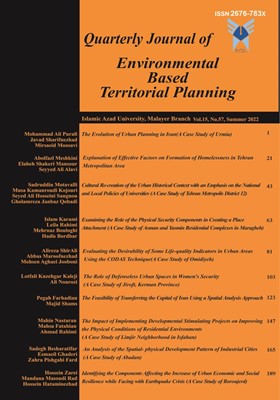-
-
List of Articles
-
Open Access Article
1 - The Evolution of Urban Planning in Iran (A Case Study of Urmia)
mohammad ali pourali javad sharifnejad mirsaeid moosavi -
Open Access Article
2 - Explanation of Effective Factors on Formation of Homelessness in Tehran Metropolitan Area
Abolfazl Meshkini Elaheh ShakeriMansour Seyyed Ali Alavi -
Open Access Article
3 - Cultural Re-creation of the Urban Historical Context with an Emphasis on the National and Local Policies of Universities (A Case Study of Tehran Metropolis District 12)
Sadraddin Motavalli Mousa Kamanroudi Seiied Ali Hosseini Sangno Gholamreza Janbaz Qobadi -
Open Access Article
4 - Examining the Role of the Physical Security Components in Creating a Place Attachment (A Case Study of Asman and Yasmin Residential Complexes in Maragheh)
Islam Karami Leila Rahimi Mehrnaz Bologhi Hadis Bordbar -
Open Access Article
5 - Evaluating the Desirability of Some Life-quality Indicators in Urban Areas Using the CODAS Technique (A Case Study of Omidiyeh)
alireza shirali Abbas Maroofnezhad Mohsen aghaei juboni -
Open Access Article
6 - The Role of Defenseless Urban Spaces in Women's Security (A Case Study of Jiroft, Kerman Province)
Lotfali Kozegar Kaleji Ali Nourozi -
Open Access Article
7 - The Feasibility of Transferring the Capital of Iran Using a Spatial Analysis Approach
pegah farhadian Majid Shams -
Open Access Article
8 - The Impact of Implementing Developmental Stimulating Projects on Improving the Physical Conditions of Residential Environments (A Case Study of Limjir Neighborhood in Isfahan)
Mahin Nastaran Mahsa Fatahian Ahmad Rahimi -
Open Access Article
9 - An Analysis of the Spatial- physical Development Pattern of Industrial Cities (A Case Study of Abadan)
sadegh besharatifar ghaderi Esmaeil Zahra Pishgahi Fard -
Open Access Article
10 - Identifying the Components Affecting the Increase of Urban Economic and Social Resilience while Facing with Earthquake Crisis (A Case Study of Boroujerd)
ali amiri hosein zareei mandana masoudy rad hosein hataminejad
-
The rights to this website are owned by the Raimag Press Management System.
Copyright © 2021-2025







